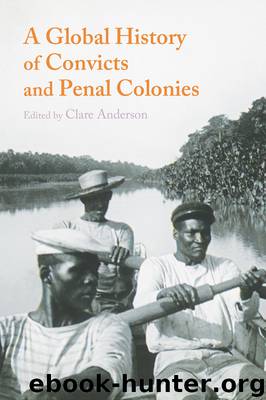A Global History of Convicts and Penal Colonies by Clare Anderson

Author:Clare Anderson
Language: eng
Format: epub
Publisher: Bloomsbury UK
The military deployment of convict labour 1702–1875
Prior to sending convicts to Australia the British had plenty of experience with the deployment of convict labour in the public sector. They had been used in dock work dredging harbours and loading warships as well as being co-opted into military service. The latter had a particularly long history. Vagrants had been impressed into military service in Elizabethan England.85 Forced military service was a convenient way of operationalizing the overseas deployment of the labour of those who had been judicially condemned.
As in the French, Spanish and Russian empires, British penal transportation systems interconnected with military labour markets in complex ways.86 It was not just rebels and prisoners of war that were at risk of transportation. Military courts were empowered to sentence members of the armed forces to transportation or continued service (usually within dedicated penal units earmarked for service in tropical areas). Those units could also take recruits sentenced to transportation by civilian courts, although the extent to which this occurred varied over time. In short, two parallel systems of transportation operated within the British Empire – one directed at supplying labour to the armed forces and the other to meet colonial public and private sector demand. Flows of convicts were switched between these systems according to wider imperial needs.
Whenever Britain was at war the number of convicts transported declined (see Figure 7.1). Shipping costs rose during Atlantic conflicts largely as the private sector had to compete with the navy for maritime labour, driving up wages. Military recruitment also resulted in fuller employment leading to a reduction in crime and hence conviction rates. In the eighteenth century military recruiters competed with the private sector for the reduced supply of convict labour. As early as the War of Spanish Succession (1702–1715), prisoners were recruited into the armed forces.87 Felons were reprieved on condition of overseas service on a regular basis from 1756 on. British units arriving in Lower Canada in that year were said to be almost entirely composed of ‘convicts and Irish Papists’.88
Download
This site does not store any files on its server. We only index and link to content provided by other sites. Please contact the content providers to delete copyright contents if any and email us, we'll remove relevant links or contents immediately.
2010-The City & the City by China Miéville(1848)
Anatomy of Injustice by Raymond Bonner(1531)
That Every Man Be Armed by Stephen P. Halbrook(1480)
ADHD on Trial by Michael Gordon(1473)
Injustices by Ian Millhiser(1408)
You Don't Own Me by Orly Lobel(1362)
Tell by Major Margaret Witt(1316)
Course Correction by Ginny Gilder(1298)
A Vast Conspiracy by Jeffrey Toobin(1254)
Broken Scales by Joel Cohen(1238)
First by Evan Thomas(1188)
J by Howard Jacobson(1183)
Without Copyrights by Spoo Robert(1183)
A Religious Orgy in Tennessee by H.L. Mencken(1155)
The Run of His Life: The People v. O. J. Simpson by Jeffrey Toobin(1139)
A Triumph of Genius: Edwin Land, Polaroid, and the Kodak Patent War by Ronald K. Fierstein(1122)
A History Of Thailand by Baker Chris(1099)
John Wayne Gacy by Judge Sam Amirante(1037)
Law 101: Everything You Need to Know About American Law, Fourth Edition by Jay Feinman(1029)
